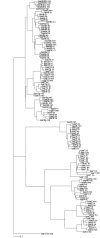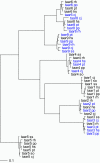Functional evolution of the trace amine associated receptors in mammals and the loss of TAAR1 in dogs
- PMID: 20167089
- PMCID: PMC2838891
- DOI: 10.1186/1471-2148-10-51
Functional evolution of the trace amine associated receptors in mammals and the loss of TAAR1 in dogs
Abstract
Background: The trace amine associated receptor family is a diverse array of GPCRs that arose before the first vertebrates walked on land. Trace amine associated receptor 1 (TAAR1) is a wide spectrum aminergic receptor that acts as a modulator in brain monoaminergic systems. Other trace amine associated receptors appear to relate to environmental perception and show a birth-and-death pattern in mammals similar to olfactory receptors.
Results: Across mammals, avians, and amphibians, the TAAR1 gene is intact and appears to be under strong purifying selection based on rates of amino acid fixation compared to neutral mutations. We have found that in dogs it has become a pseudogene. Our analyses using a comparative genetics approach revealed that the pseudogenization event predated the emergence of the Canini tribe rather than being coincident with canine domestication. By assessing the effects of the TAAR1 agonist beta-phenylethylamine on [3H]dopamine uptake in canine striatal synaptosomes and comparing the degree and pattern of uptake inhibition to that seen in other mammals, including TAAR1 knockout mice, wild type mice and rhesus monkey, we found that the TAAR1 pseudogenization event resulted in an uncompensated loss of function.
Conclusion: The gene family has seen expansions among certain mammals, notably rodents, and reductions in others, including primates. By placing the trace amine associated receptors in an evolutionary context we can better understand their function and their potential associations with behavior and neurological disease.
Figures






Similar articles
-
Normal thermoregulatory responses to 3-iodothyronamine, trace amines and amphetamine-like psychostimulants in trace amine associated receptor 1 knockout mice.J Neurosci Res. 2010 Jul;88(9):1962-9. doi: 10.1002/jnr.22367. J Neurosci Res. 2010. PMID: 20155805 Free PMC article.
-
Beta-phenylethylamine alters monoamine transporter function via trace amine-associated receptor 1: implication for modulatory roles of trace amines in brain.J Pharmacol Exp Ther. 2008 May;325(2):617-28. doi: 10.1124/jpet.107.134247. Epub 2008 Jan 8. J Pharmacol Exp Ther. 2008. PMID: 18182557
-
Trace amine-associated receptor 1 as a monoaminergic modulator in brain.Biochem Pharmacol. 2009 Nov 1;78(9):1095-104. doi: 10.1016/j.bcp.2009.05.031. Epub 2009 May 29. Biochem Pharmacol. 2009. PMID: 19482011 Free PMC article.
-
Trace amine-associated receptor 1 (TAAR1) agonism as a new treatment strategy for schizophrenia and related disorders.Trends Neurosci. 2023 Jan;46(1):60-74. doi: 10.1016/j.tins.2022.10.010. Epub 2022 Nov 8. Trends Neurosci. 2023. PMID: 36369028 Review.
-
Trace Amines and Their Receptors.Pharmacol Rev. 2018 Jul;70(3):549-620. doi: 10.1124/pr.117.015305. Pharmacol Rev. 2018. PMID: 29941461 Review.
Cited by
-
Inverse agonistic action of 3-iodothyronamine at the human trace amine-associated receptor 5.PLoS One. 2015 Feb 23;10(2):e0117774. doi: 10.1371/journal.pone.0117774. eCollection 2015. PLoS One. 2015. PMID: 25706283 Free PMC article.
-
Accelerated pseudogenization of trace amine-associated receptor genes in primates.Genes Brain Behav. 2019 Jul;18(6):e12543. doi: 10.1111/gbb.12543. Epub 2019 Jan 9. Genes Brain Behav. 2019. PMID: 30536583 Free PMC article.
-
Identifying human diamine sensors for death related putrescine and cadaverine molecules.PLoS Comput Biol. 2018 Jan 11;14(1):e1005945. doi: 10.1371/journal.pcbi.1005945. eCollection 2018 Jan. PLoS Comput Biol. 2018. PMID: 29324768 Free PMC article.
-
Methamphetamine induces trace amine-associated receptor 1 (TAAR1) expression in human T lymphocytes: role in immunomodulation.J Leukoc Biol. 2016 Jan;99(1):213-23. doi: 10.1189/jlb.4A0814-395RR. Epub 2015 Aug 24. J Leukoc Biol. 2016. PMID: 26302754 Free PMC article.
-
Timberol® Inhibits TAAR5-Mediated Responses to Trimethylamine and Influences the Olfactory Threshold in Humans.PLoS One. 2015 Dec 18;10(12):e0144704. doi: 10.1371/journal.pone.0144704. eCollection 2015. PLoS One. 2015. PMID: 26684881 Free PMC article.
References
-
- Bunzow JR, Sonders MS, Arttamangkul S, Harrison LM, Zhang G, Quigley DI, Darland T, Suchland KL, Pasumamula S, Kennedy JL. Amphetamine, 3,4-methylenedioxymethamphetamine, lysergic acid diethylamide, and metabolites of the catecholamine neurotransmitters are agonists of a rat trace amine receptor. Mol Pharmacol. 2001;60(6):1181–1188. - PubMed
-
- Xie Z, Westmoreland SV, Miller GM. Modulation of monoamine transporters by common biogenic amines via trace amine-associated receptor 1 and monoamine autoreceptors in human embryonic kidney 293 cells and brain synaptosomes. J Pharmacol Exp Ther. 2008;325(2):629–640. doi: 10.1124/jpet.107.135079. - DOI - PubMed
Publication types
MeSH terms
Substances
Grants and funding
LinkOut - more resources
Full Text Sources
Molecular Biology Databases

